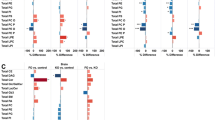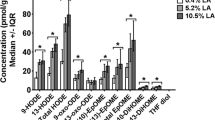Abstract
Fat-1 transgenic mice endogenously convert n-6 to n-3 polyunsaturated fatty acids (PUFA). The aims of this study were to test whether a) fish oil feeding can attain similar brain n-3 PUFA levels as the fat-1 mouse, and b) fat-1 mouse brain docosahexaenoic acid (22:6n-3; DHA) levels can be potentiated by fish oil feeding. Fat-1 mice and their wildtype littermates consumed either a 10% safflower oil (SO) or a 2% fish oil and 8% safflower oil chow (FO). Brain total lipid and phospholipid fraction fatty acids were analyzed using GC-FID. Wildtype mice fed FO chow had similar brain levels of DHA as fat-1 mice fed SO chow. Fat-1 mice fed FO chow had similar brain n-3 PUFA levels as fat-1 mice fed SO chow. In conclusion, brain levels of DHA in the fat-1 mouse can be obtained by and were not further augmented with fish oil feeding.

Similar content being viewed by others
Abbreviations
- 20:4n-6:
-
Arachidonic acid
- ChoGpl:
-
Choline glycerophospholipids
- DHA:
-
Docosahexaenoic acid
- EtnGpl:
-
Ethanolamine glycerophospholipids
- FO:
-
2% fish oil, 8% safflower oil chow
- 18:1:
-
n-9 oleic acid
- 16:0:
-
Palmitic acid
- PtdIns:
-
Phosphatidylinositol
- PtdSer:
-
Phosphatidylserine
- PUFA:
-
Polyunsaturated fatty acid
- SO:
-
10% safflower oil chow
- 18:0:
-
Stearic acid
References
Alessandri JM, Guesnet P, Vancassel S et al (2004) Polyunsaturated fatty acids in the central nervous system: evolution of concepts and nutritional implications throughout life. Reprod Nutr Dev 44:509–538
Lukiw WJ, Bazan NG (2008) Docosahexaenoic acid and the aging brain. J Nutr 138:2510–2514
Stahl LA, Begg DP, Weisinger RS et al (2008) The role of omega-3 fatty acids in mood disorders. Curr Opin Investig Drugs 9:57–64
Calder PC (2009) Polyunsaturated fatty acids and inflammatory processes: new twists in an old tale. Biochimie 91:791–795
Orr SK, Bazinet RP (2008) The emerging role of docosahexaenoic acid in neuroinflammation. Curr Opin Investig Drugs 9:735–743
Soderberg M, Edlund C, Kristensson K et al (1991) Fatty acid composition of brain phospholipids in aging and in Alzheimer’s disease. Lipids 26:421–425
Skinner ER, Watt C, Besson JA et al (1993) Differences in the fatty acid composition of the grey and white matter of different regions of the brains of patients with Alzheimer’s disease and control subjects. Brain 116(Pt 3):717–725
Prasad MR, Lovell MA, Yatin M et al (1998) Regional membrane phospholipid alterations in Alzheimer’s disease. Neurochem Res 23:81–88
Corrigan FM, Horrobin DF, Skinner ER et al (1998) Abnormal content of n-6 and n-3 long-chain unsaturated fatty acids in the phosphoglycerides and cholesterol esters of parahippocampal cortex from Alzheimer’s disease patients and its relationship to acetyl CoA content. Int J Biochem Cell Biol 30:197–207
Lukiw WJ, Cui JG, Marcheselli VL et al (2005) A role for docosahexaenoic acid-derived neuroprotectin D1 in neural cell survival and Alzheimer disease. J Clin Invest 115:2774–2783
Fraser T, Tayler H, Love S (2010) Fatty acid composition of frontal, temporal and parietal neocortex in the normal human brain and in Alzheimer’s disease. Neurochem Res 35:503–513
McNamara RK, Jandacek R, Rider T et al (2007) Abnormalities in the fatty acid composition of the postmortem orbitofrontal cortex of schizophrenic patients: gender differences and partial normalization with antipsychotic medications. Schizophr Res 91:37–50
Yao JK, Leonard S, Reddy RD (2000) Membrane phospholipid abnormalities in postmortem brains from schizophrenic patients. Schizophr Res 42:7–17
McNamara RK, Hahn CG, Jandacek R et al (2007) Selective deficits in the omega-3 fatty acid docosahexaenoic acid in the postmortem orbitofrontal cortex of patients with major depressive disorder. Biol Psychiatry 62:17–24
Lalovic A, Levy E, Canetti L et al (2007) Fatty acid composition in postmortem brains of people who completed suicide. J Psychiatry Neurosci 32:363–370
McNamara RK, Jandacek R, Rider T et al (2009) Fatty acid composition of the postmortem prefrontal cortex of adolescent male and female suicide victims. Prostaglandins Leukot Essent Fatty Acids 80:19–26
Chen CT, Green JT, Orr SK et al (2008) Regulation of brain polyunsaturated fatty acid uptake and turnover. Prostaglandins Leukot Essent Fatty Acids 79:85–91
Hamilton JA, Brunaldi K (2007) A model for fatty acid transport into the brain. J Mol Neurosci 33:12–17
Rapoport SI, Rao JS, Igarashi M (2007) Brain metabolism of nutritionally essential polyunsaturated fatty acids depends on both the diet and the liver. Prostaglandins Leukot Essent Fatty Acids 77:251–261
Green JT, Orr SK, Bazinet RP (2008) The emerging role of group VI calcium-independent phospholipase A2 in releasing docosahexaenoic acid from brain phospholipids. J Lipid Res 49:939–944
Darios F, Davletov B (2006) Omega-3 and omega-6 fatty acids stimulate cell membrane expansion by acting on syntaxin 3. Nature 440:813–817
Poling JS, Karanian JW, Salem N Jr et al (1995) Time- and voltage-dependent block of delayed rectifier potassium channels by docosahexaenoic acid. Mol Pharmacol 47:381–390
Poling JS, Vicini S, Rogawski MA et al (1996) Docosahexaenoic acid block of neuronal voltage-gated K+ channels: subunit selective antagonism by zinc. Neuropharmacology 35:969–982
Vreugdenhil M, Bruehl C, Voskuyl RA et al (1996) Polyunsaturated fatty acids modulate sodium and calcium currents in CA1 neurons. Proc Natl Acad Sci U S A 93:12559–12563
Nishikawa M, Kimura S, Akaike N (1994) Facilitatory effect of docosahexaenoic acid on N-methyl-D-aspartate response in pyramidal neurones of rat cerebral cortex. J Physiol 475:83–93
Hsieh AT, Anthony JC, Diersen-Schade DA et al (2007) The influence of moderate and high dietary long chain polyunsaturated fatty acids (LCPUFA) on baboon neonate tissue fatty acids. Pediatr Res 61:537–545
Bourre JM, Francois M, Youyou A et al (1989) The effects of dietary alpha-linolenic acid on the composition of nerve membranes, enzymatic activity, amplitude of electrophysiological parameters, resistance to poisons and performance of learning tasks in rats. J Nutr 119:1880–1892
Huang MC, Brenna JT, Chao AC et al (2007) Differential tissue dose responses of (n-3) and (n-6) PUFA in neonatal piglets fed docosahexaenoate and arachidonoate. J Nutr 137:2049–2055
Kang JX, Wang J, Wu L et al (2004) Transgenic mice: fat-1 mice convert n-6 to n-3 fatty acids. Nature 427:504
Taha AY, Huot PS, Reza-Lopez S et al (2008) Seizure resistance in fat-1 transgenic mice endogenously synthesizing high levels of omega-3 polyunsaturated fatty acids. J Neurochem 105:380–388
He C, Qu X, Cui L et al (2009) Improved spatial learning performance of fat-1 mice is associated with enhanced neurogenesis and neuritogenesis by docosahexaenoic acid. Proc Natl Acad Sci U S A 106:11370–11375
Boudrault C, Bazinet RP, Kang JX, et al. Cyclooxygenase-2 and n-6 PUFA are lower and DHA is higher in the cortex of fat-1 mice. Neurochem Int. doi:10.1016/j.physletb.2003.10.071
Canadian Council on Animal Care (1993) Guide to the care and use of experimental animals. Canadian Council on Animal Care, Ottawa
Dobbing J, Sands J (1979) Comparative aspects of the brain growth spurt. Early Hum Dev 3:79–83
Ward G, Woods J, Reyzer M et al (1996) Artificial rearing of infant rats on milk formula deficient in n-3 essential fatty acids: a rapid method for the production of experimental n-3 deficiency. Lipids 31:71–77
Lee HJ, Rao JS, Chang L et al (2007) Chronic lamotrigine does not alter the turnover of arachidonic acid within brain phospholipids of the unanesthetized rat: implications for the treatment of bipolar disorder. Psychopharmacology (Berl) 193:467–474
Lee HJ, Rao JS, Rapoport SI et al (2007) Antimanic therapies target brain arachidonic acid signaling: lessons learned about the regulation of brain fatty acid metabolism. Prostaglandins Leukot Essent Fatty Acids 77:239–246
Folch J, Lees M, Sloane Stanley GH (1957) A simple method for the isolation and purification of total lipides from animal tissues. J Biol Chem 226:497–509
Murthy M, Hamilton J, Greiner RS et al (2002) Differential effects of n-3 fatty acid deficiency on phospholipid molecular species composition in the rat hippocampus. J Lipid Res 43:611–617
Hussein N, Fedorova I, Moriguchi T et al (2009) Artificial rearing of infant mice leads to n-3 fatty acid deficiency in cardiac, neural and peripheral tissues. Lipids 44:685–702
Stark KD, Lim SY, Salem N Jr (2007) Artificial rearing with docosahexaenoic acid and n-6 docosapentaenoic acid alters rat tissue fatty acid composition. J Lipid Res 48:2471–2477
Igarashi M, DeMar JC Jr, Ma K et al (2007) Docosahexaenoic acid synthesis from alpha-linolenic acid by rat brain is unaffected by dietary n-3 PUFA deprivation. J Lipid Res 48:1150–1158
DeMar JC Jr, Ma K, Bell JM et al (2004) Half-lives of docosahexaenoic acid in rat brain phospholipids are prolonged by 15 weeks of nutritional deprivation of n-3 polyunsaturated fatty acids. J Neurochem 91:1125–1137
Contreras MA, Chang MC, Rosenberger TA et al (2001) Chronic nutritional deprivation of n-3 alpha-linolenic acid does not affect n-6 arachidonic acid recycling within brain phospholipids of awake rats. J Neurochem 79:1090–1099
Green JT, Liu Z, Bazinet RP (2009) Brain phospholipid arachidonic acid half lives are not altered following 15 weeks of n-3 polyunsaturated fatty acid adequate or deprived diet. J Lipid Res 51:535–543
Hudert CA, Weylandt KH, Lu Y et al (2006) Transgenic mice rich in endogenous omega-3 fatty acids are protected from colitis. Proc Natl Acad Sci U S A 103:11276–11281
Lau BY, Ward WE, Kang JX et al (2009) Femur EPA and DHA are correlated with femur biomechanical strength in young fat-1 mice. J Nutr Biochem 20:453–461
Lau BY, Ward WE, Kang JX et al (2009) Vertebrae of developing fat-1 mice have greater strength and lower n-6/n-3 fatty acid ratio. Exp Biol Med (Maywood) 234:632–638
Mayer K, Kiessling A, Ott J et al (2009) Acute lung injury is reduced in fat-1 mice endogenously synthesizing n-3 fatty acids. Am J Respir Crit Care Med 179:474–483
Weylandt KH, Nadolny A, Kahlke L et al (2008) Reduction of inflammation and chronic tissue damage by omega-3 fatty acids in fat-1 transgenic mice with pancreatitis. Biochim Biophys Acta 1782:634–641
Jia Q, Lupton JR, Smith R et al (2008) Reduced colitis-associated colon cancer in Fat-1 (n-3 fatty acid desaturase) transgenic mice. Cancer Res 68:3985–3991
Nowak J, Weylandt KH, Habbel P et al (2007) Colitis-associated colon tumorigenesis is suppressed in transgenic mice rich in endogenous n-3 fatty acids. Carcinogenesis 28:1991–1995
Schmocker C, Weylandt KH, Kahlke L et al (2007) Omega-3 fatty acids alleviate chemically induced acute hepatitis by suppression of cytokines. Hepatology 45:864–869
Menesi D, Kitajka K, Molnar E et al (2009) Gene and protein expression profiling of the fat-1 mouse brain. Prostaglandins Leukot Essent Fatty Acids 80:33–42
Chen CT, Ma DW, Kim JH et al (2008) The low density lipoprotein receptor is not necessary for maintaining mouse brain polyunsaturated fatty acid concentrations. J Lipid Res 49:147–152
Ouellet M, Emond V, Chen CT et al (2009) Diffusion of docosahexaenoic and eicosapentaenoic acids through the blood-brain barrier: an in situ cerebral perfusion study. Neurochem Int 55:476–482
Greiner RS, Catalan JN, Moriguchi T et al (2003) Docosapentaenoic acid does not completely replace DHA in n-3 FA-deficient rats during early development. Lipids 38:431–435
Moriguchi T, Lim SY, Greiner R et al (2004) Effects of an n-3-deficient diet on brain, retina, and liver fatty acyl composition in artificially reared rats. J Lipid Res 45:1437–1445
Acknowledgments
This work was supported by grants from the Natural Sciences and Engineering Research Council of Canada (NSERC) to DWL Ma and RP Bazinet, and from the Canadian Institutes of Health Research to RP Bazinet. SK Orr received financial support from NSERC.
Author information
Authors and Affiliations
Corresponding author
Additional information
S. K. Orr and J. Y. M. Tong contributed equally to this work.
Electronic Supplementary Material
Below is the link to the electronic supplementary material.
Rights and permissions
About this article
Cite this article
Orr, S.K., Tong, J.Y.M., Kang, J.X. et al. The Fat-1 Mouse has Brain Docosahexaenoic Acid Levels Achievable Through Fish Oil Feeding. Neurochem Res 35, 811–819 (2010). https://doi.org/10.1007/s11064-010-0139-x
Accepted:
Published:
Issue Date:
DOI: https://doi.org/10.1007/s11064-010-0139-x




